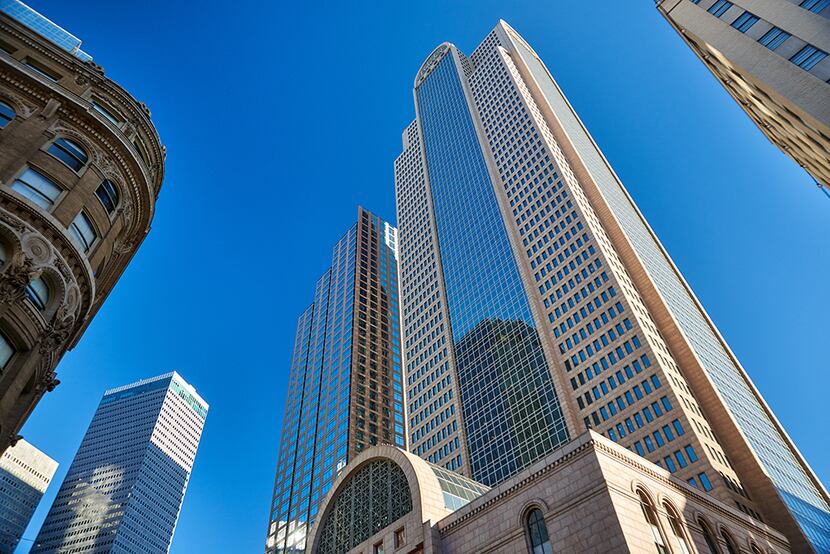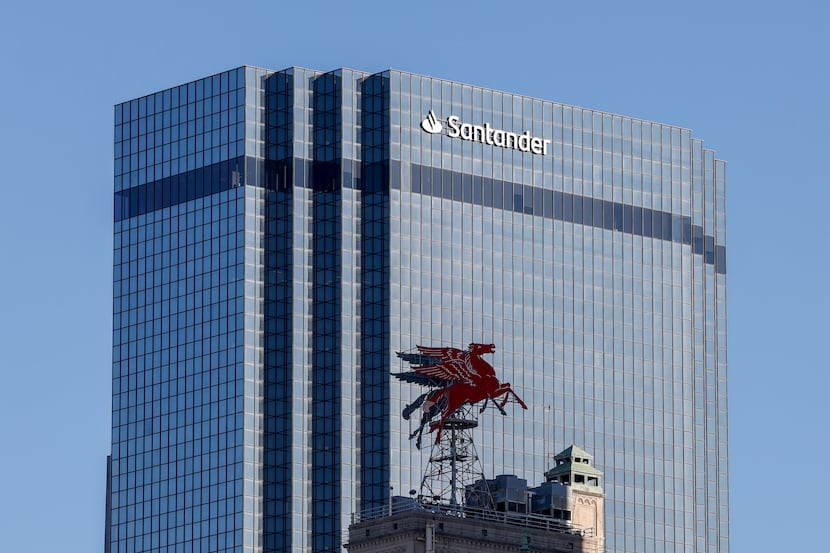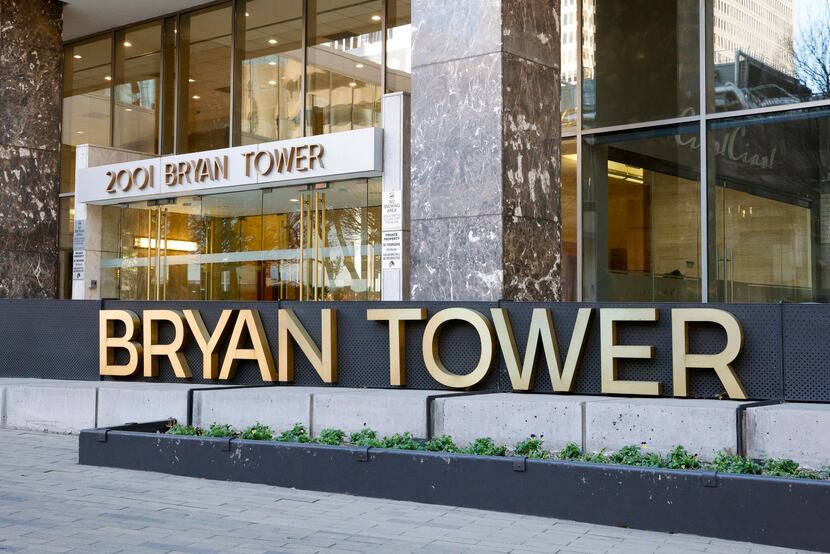Standing between the flourishing East Quarter neighborhood redevelopment and a sparkling $100 million entertainment district developed by AT&T, a massive 60-story tower with Comerica as its nameplate tenant has missed out on downtown Dallas’ revival.
Its new owner is working on a plan to catch up.
The landmark high-rise, one of the last towers completed in Dallas’ 1980s building boom, could see as many as 20 stories turned into apartments, a luxury hotel and additional retail stores.
“We believe a mixed-use tower is much more likely to be successful today than a more than one million-square-foot office tower,” said Jonas Woods, whose company Pacific Elm Properties just acquired a major ownership position in the Comerica tower.
Woods already has conversions underway of two other downtown office skyscrapers — Santander Tower and Bryan Tower. He’s working with longtime building owner TriGate Property Partners on the Comerica plan.
“Our development projects are all a combination of office, residential, hospitality and food and beverage,” he said. “We think there is a very interesting opportunity to convert a large portion of Comerica Tower into a luxury hotel.
“Some of the hotel flags come with a residential component,” Woods said. “They would be very high-end luxury residences, and in that building, appropriately so.”
Offices would remain in the 36-year-old tower’s top floors, he said.
The tower’s original vision
Built as the headquarters of a regional bank, the granite-clad post-modern skyscraper was designed by late renowned architect Philip Johnson and his partner John Burgee.
In the more than three decades since the building opened, demand for office space in Dallas’ financial district has declined. Developers are now revamping older towers with new uses.
The Comerica tower’s owners are going to spend the next few months getting architectural proposals and refining plans, Woods said.

“We are in discussions with several hotel operators and there is a very strong interest in participating,” Woods said. “A hotel would really change the composition of the building from an activity and energy perspective. It would bring more life to that block.”
An energy boost for the Comerica tower would complement what’s been happening around it.
Just east is a rejuvenated part of downtown Dallas now known as the East Quarter. Todd Interests and partners have been redeveloping the 20-block area on the east side of downtown since 2018. They’ve attracted buzzy new restaurants and high-tech tenants and put up a 20-story office and apartment tower.
To the west, AT&T’s Discovery District has become one of downtown’s biggest draws, regularly attracting weekend crowds with its big-screen displays and Instagram-friendly settings. That followed an earlier expansion of the nearby Joule luxury hotel.
Architects Johnson and Burgee had hoped to include a large retail component in the skyscraper — their biggest Dallas development design after Uptown’s Crescent. Their original plan was actually for a trio of buildings on the Main Street block — two office towers linked by a retail arcade.
But the head honchos of then-building owner MBank were against the plan to open their grand headquarters to downtown retail shoppers. MBank-Dallas was the largest institution of MCorp, once the largest bank holding company in Texas. The FDIC took over MBank-Dallas and 19 other member banks in March 1989 in one of the biggest bank failures in the country.
Johnson later said the snub of the original design made the project “the hardest job I guess we ever had,” even though he was pleased with the final result.
“It’s not in any particular design — it’s not gothic, it’s not modern,” Johnson said when the building was completed. “We think it has terrific character. It’s truly what you call a skyscraper, and not just another tall building.”
‘It’s a fortress’
Thanks to the decision to not include retail, today’s Comerica tower isn’t as street friendly as other downtown buildings.
“It’s a fortress today,” Woods said. “It has that feel intentionally.”
Woods expects the redevelopment to include the addition of retail and outdoor spaces on the ground level — especially on the west side of the tower facing Ervay Street.
“With new uses occupying the first floor and the below-level spaces, you have the opportunity to really open it up and engage the urban neighborhood in a way it wasn’t originally conceived,” he said. “It can create a very dynamic space.”
Woods points to the success of the recent repositioning of the Trammell Crow Center tower on Ross Avenue, which added multiple restaurant and retail venues to a 1980s high-rise. Trammell Crow Center sold last year for a record downtown price of more than $615 million.
“It’s an extremely well-done project,” Woods said. “It’s been the most impactful and the street has a ton of activity now.”
Dallas’ first JW Marriott Hotel is opening this year across the street as part of the Crow Center redevelopment.
Woods said any redevelopment plan for the Comerica tower will be respectful of its original design.
“Architecturally, it’s a stunning property,” he said. “What Philip Johnson did there is truly special. Everything was the absolute best it could be. I don’t think anybody would ever endeavor to build something of that level of luxury today.”

The skyscraper makeover era
Woods’ Pacific Elm Properties is already in the midst of one downtown Dallas skyscraper renovation and is about to begin another.
The developer and its partners are converting part of the 50-story Santander Tower at 1601 Elm St. for residential use. About 400,000 square feet of offices in the high-rise are being repurposed as 290 apartments. Two upper floors of the more than four-decade-old tower were previously rebuilt as hotel rooms.
“At Santander Tower, we are well underway,” Woods said. A new tenant lounge, lobby and outdoor space with a swimming pool are being constructed on the west side of Santander Tower.
“We will have our first residents moving in this summer and expect to be fully complete with construction by the end of this year.”
Four blocks away at the Bryan Tower, the plan is to add 400 apartments in what is now vacant office space in the 40-story building. The 1.1 million-square-foot high-rise was only about 35% occupied when it was acquired by Woods’ firm.
“We are converting a half million square feet of offices,” Woods said. “You will see construction start there in the second quarter.”
The planned building renovations by Woods’ company and other building redevelopments are taking millions of square feet of surplus office space off the downtown market. With nationwide office vacancies at a three-decade high, building owners across the country are scrambling to find new uses for empty office towers.
Even with the recent conversions, almost 30% of downtown’s office space is empty — the most of any North Texas business district. Downtown office vacancy has grown by about 5 percentage points since the start of the COVID-19 pandemic.
Dallas’ central business district has more than 28 million square feet of offices. The Las Colinas area in Irving and the West Plano-Frisco area have each now surpassed downtown Dallas in total office space, according to Cushman & Wakefield.
Downtown’s resident population has grown by 71% in the past decade, according to Downtown Dallas Inc. Existing residential units are more than 90% occupied.
“We are just under 15,000 residents downtown and we have major projects in conversions and an increasing number of planned new buildings,” said Downtown Dallas Inc. CEO Jennifer Scripps.
Downtown will always be an office hub, Scripps said, but adding residential space and removing unneeded offices strengthens the business district.
“It has really helped downtown Dallas be more resilient compared to other downtowns,” Scripps said. “We are reading about downtowns that still feel like they have been completely deserted.
“Those bigger buildings, as soon as they get converted to residential, there aren’t going to be too many underutilized assets.”
Last year, an estimated 12 million square feet of office space around the country was switched to other uses. Conversions are expected to total about 20 million square feet this year, according to estimates from CBRE Group.

Other downtown Dallas office skyscrapers, including the 49-story Energy Plaza on Bryan Street and the 56-story Renaissance Tower, are also eyeing new uses. Several have already made the transition, including The National and One Dallas Centre.
The makeovers are effectively dialing down an office glut and boosting living choices for urban dwellers.
“We are seeing the tide turn and residential is clearly leading,” Woods said.

